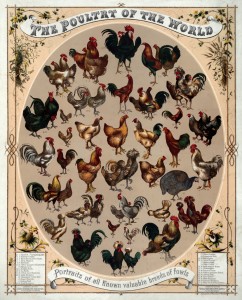- People of Rapa Nui innovated as they collapsed.
- “Extinct” Bird Seen, Eaten. Sorry, National Geographic, but I can’t better that headline. Worthy of Fark.
- Kimchi madness.
- Coming to a protected are near you: moving species to save them from climate change. CWR, anyone?
- Shrinking the C footprint of traditional peanut processing. Via.
- 15 Evolutionary Gems: alas, nothing from crops, livestock. Surely domestication could have made it in there.
- “Bulgarian wine cellars have already announced that they will plant vines with the mysterious and newly recovered variety of grapes near the Orpheus tomb.”
- And more ancient wine, this time from Malta.
- Bioversity International wises up on dismal science, launches new economics webpages.
- Wild forest foods big hit at FAO booth at Lao and International Food Festival last weekend in Vientiane.
Nibbles: Rescue, Biofuels, Striga, Dogs, Vegetable seed, Mulberry, Afghanistan, Aquaculture, Abaca
- Global Crop Diversity Trust “on track” to reinvigorate 100,000 varieties, “one of the largest and most successful biological rescue efforts ever undertaken”. Jeremy says: “Kariba Dam.”
- More reasons to go perennial. And native to boot.
- Farmers go crazy with Striga-resistant maize.
- Design-a-pooch just around the corner, thanks to genome sequencing. Well it was all worth it then, wasn’t it.
- AVRDC teaches Solomons farmers to save seeds, grandma to suck eggs.
- Mulberries cryopreserved. Yay! Now for that productivity.
- Turning grapes to raisins, swords to plowshares, in Afghanistan.
- District Fishery Officer (In-charge) tells of guy “farming in a floodplain adjacent to Coler Beel under the same upazila and earns a net profit of Taka 9 lakh after selling 80 metric tons of harvested fish from the Beel last year.”
- Abaca: quantity or quality?
Nibbles: Paan, Homegardens, Yams, Apiculture, Sorghum, Asparagus, Vicuna
- Paan unwrapped — betel leaf, areca nut.
- “We were suffering; we had no food to eat so we tried to make a garden.”
- IITA comes up with technique to propagate yams through vine cuttings using carbonized rice husks as growth medium. Worlds beats path to Ibadan.
- The Virgin Fresh Apicultural Project is cool, but needs a new name.
- Sorghum makes big move from wallboards to gas and booze.
- Great Witley sweeter than Peruvian. No, not weed, dude.
- The vicuna: use it or lose it. They did, so they didn’t.
Invasion of the (edible) killer crabs
Two stories of invasives, one with a silver lining (perhaps), the other not so much.
The Chinese mitten crab has settled in the Thames, causing trouble of varied sorts. Bad. Boffins at the Natural History Museum think it can be harvested and sold in restaurants and special food shops. Good. I look forward to seeing participants at the Henley Royal Regatta dodging around the crab farms.
And from Utah — the Beehive State, ironically — the first sightings of Africanized “killer” bees. As if bees didn’t have enough problems already, what with their colonies collapsing and everything. Never rains but it pours.
LATER: And here’s another invasive you can eat.
LATER STILL: There’s a nice roundup of Colony Collapse Disorder at CABI’s blog.
Blogging the big birthday: Chickens of the world
I’d like to think Darwin might have had this poster, or something like it, in mind as he wrote the following words in the Domestication. But then he would have acknowledged it. He was meticulous about that.
As some naturalists may not be familiar with the chief breeds of the fowl, it will be advisable to give a condensed description of them. From what I have read and seen of specimens brought from several quarters of the world, I believe that most of the chief kinds have been imported into England, but many sub-breeds are probably still here unknown. The following discussion on the origin of the various breeds and on their characteristic differences does not pretend to completeness, but may be of some interest to the naturalist. The classification of the breeds cannot, as far as I can see, be made natural. They differ from each other in different degrees, and do not afford characters in subordination to each other, by which they can be ranked in group under group. They seem all to have diverged by independent and different roads from a single type.
The poultry of the world. Portraits of all known valuable breeds of fowl. Fifty-two types of identified chickens. Chromolithograph by L. Prang & Co., Boston, ca. 1868. From the Performing Arts Poster Collection at the U.S. Library of Congress. [PD] This picture is in the public domain. Downloaded from flickr.
